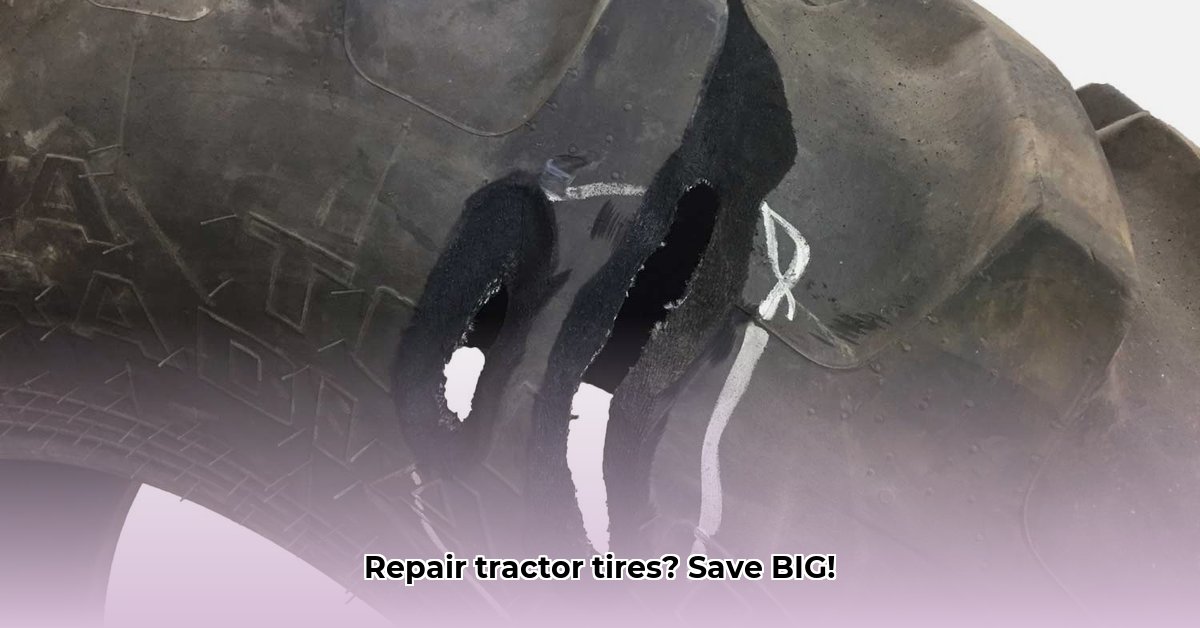
Let's be honest, tractor tire repairs can be expensive. But there's a smarter, greener alternative: DIY patching! This guide shows you how to save money and reduce waste by fixing your tractor tires yourself. We'll cover everything from safety to advanced techniques, helping you keep your tractor running smoothly and efficiently. Remember, though, some damage requires professional attention. For more on tire maintenance, see this helpful guide on fluid filling.
Safety First: Protecting Yourself While Repairing Tires
Before you start, safety is paramount. Think of this as preparing for any other important task – you wouldn't start a complex project without the right precautions, would you? This includes:
- Eye Protection: Flying debris can cause serious eye injuries. Safety glasses or goggles are essential.
- Gloves: Protect your hands from cuts, chemicals, and dirt. Heavy-duty work gloves are ideal.
- Proper Jacking and Support: Use a jack designed for the weight of your tractor and always use jack stands. Never work under a raised tractor supported only by a jack. This prevents potentially fatal accidents.
- Ventilation: Tire patch kits often release fumes. Work in a well-ventilated area or use respiratory protection.
- Clean Work Area: Keep the area clear of tripping hazards. A clean workspace improves efficiency and safety.
Ignoring these steps is risky. Your safety is priceless.
Assessing the Damage: Repairable or Not?
Not all tire damage is fixable at home. Inspect carefully; taking photos might help. Key factors to consider:
- Small Punctures: These tiny holes (smaller than a pencil tip) are often easily patched.
- Shallow Cuts: Shallow cuts (less than half an inch) might be repairable, but ensure they don't reach the tire's structural layers.
- Major Tears or Sidewall Damage: Large tears, sidewall damage, or significant bulges require professional help. These are generally beyond the scope of a simple at-home repair.
- Embedded Objects: Deeply embedded objects often necessitate professional removal.
When in doubt, consult a tire professional.
Tools and Materials: What You'll Need
You don't need a full shop, but the right tools are crucial. Consider these:
- Tire Repair Kit: Choose a kit designed for tractor tires, including plugs, patches, and adhesive.
- Tire Irons (or Bead Breakers): Essential for removing the tire bead from the rim.
- Jack and Jack Stands: For safely lifting and supporting the tractor wheel.
- Air Compressor: To inflate the tire after repair.
- Cleaning Supplies: A stiff brush, rags, and a suitable cleaning solvent.
- Optional: Tire Pressure Gauge: For accurate inflation.
Look for eco-friendly options whenever possible. Many manufacturers offer sustainable alternatives.
Step-by-Step Repair Process: A Practical Guide
Preparation: Safely jack up and support the tractor. Remove the wheel. Clean the puncture area thoroughly.
Locating the Puncture: Carefully inspect the inner tube or tire to find the puncture. Soapy water can help locate air leaks.
Plug Insertion (Small Punctures): For small punctures, use a tire plug, following the kit's instructions carefully. Ensure a tight seal.
Patch Application (Larger Punctures): For larger punctures or cuts, use a patch. Clean the area thoroughly and apply the patch according to the instructions.
Reassembly and Inflation: Remount the tire, ensuring the bead seats correctly. Slowly inflate to the recommended pressure, checking for leaks. Repeat patching or consult a professional if leaks persist.
Lowering and Final Check: Carefully lower the tractor and check the tire pressure again.
Post-Repair Inspection and Maintenance
After the repair, monitor tire pressure for a few days. A pressure drop indicates a leak. Regular inspections are crucial for catching problems early. Check for wear, cuts, or embedded objects.
Advanced Techniques (Optional): For Experienced Users
More complex repairs (e.g., patching larger punctures) require advanced techniques and experience. Prioritize safety; if uncomfortable, seek professional help.
Conclusion: Save Money, Protect the Environment
DIY tire patching saves money and reduces waste. By extending tire life, you contribute to a greener future. Remember, while DIY offers significant advantages, safety is paramount. For repairs beyond your skill level, always consult a professional.